2015 Sacramento, California, USA
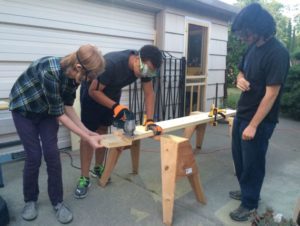
As Noah Crockette, Jack Gumbiner, William Neves, and Jacob Reynolds, students at the MET Sacramento High School, researched environmental issues in the agricultural landscape surrounding Sacramento, they became concerned with the threats pollinators were facing. In many places, pollinators, and their essential service of pollination, are at risk from habitat loss, pesticide use, and introduced diseases. They also found that since the 1990’s, bee biologists started to notice a decline in the abundance and distribution of several wild bumblebee species. These students decided to focus their efforts on bumblebee conservation by creating habitat for this particular species group. With Caring for Our Watersheds project funds, they were able to build four bumblebee boxes and install them on a farm located near Dry Creek in the Sacramento River Watershed.
Native Pollinator Project – Plantings and Information Kiosk
2015 Auburn, California, USA
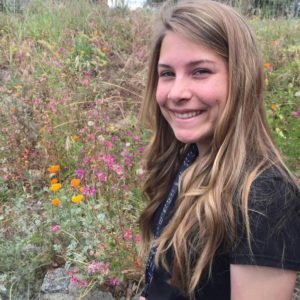
Antelope High School student Emma Forester partnered with Placer Land Trust to complete a project focused on increasing habitat for native pollinators. As Emma researched pollinators and the essential service they provide to agriculture and natural vegetation, she learned of issues and threats to their survival from habitat loss, pesticide use, and introduced diseases. She decided she could help by planting native species to increase pollinator habitat and with the help of Placer Land Trust, found a perfect location at Auburn School Park, adjacent to a community garden. By providing nectar sources to forage in, she would encourage bees and other pollinators to help pollinate the plants in the community garden. Her plantings would also help stabilize the slope next to the garden that was weedy and prone to erosion.
After clearing the weeds and prepping the area, Emma planted several pounds native flowering plant seeds. As she returned the following season, she saw that “the flowers bloomed beautifully and there were tons of little black bumble bees that are buzzing around!” After the initial seed planting, Caring for Our Watersheds project funds allowed Emma and volunteers to terrace 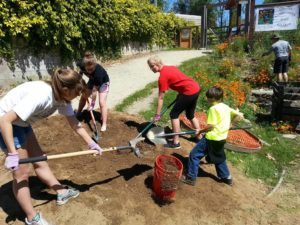
another slope and plant small shrubs and forbs there. Emma, with her dad’s help, built a kiosk to hold information about her pollinator project and other garden information. She also built a bee box for native burrowing bees like carpenter bees and bumble bees that will be mounted in a far corner of the garden where it won’t be disturbed.
As an extension to her project, Emma is working on both an educational pamphlet for the garden and a short awareness video that can be used by Placer Land Trust in their educational tours.
Restoration and Invasive Removal at Consumnes
2015 Galt, California, USA
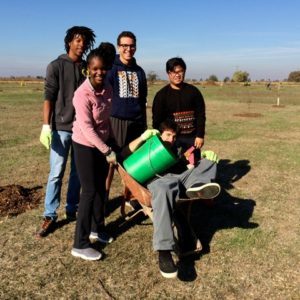
Students at Christian Brothers High School (CBHS) implemented a project first proposed by their fellow classmate, Tristan Trillo. Tristan originally proposed an invasive species removal and native plant restoration project along Sacramento River.
When it became apparent that the original site would not be possible, we helped connect students with land managers at the Cosumnes River Preserve, who welcomed students’ help with a habitat restoration/ expansion project along a tributary in the preserve.
Students helped to remove invasive species in the restoration area, as well as re-mulching and watering existing trees and replanting if necessary. Their work helped to reduce competition from non-native species in the area and, as the planted trees grow, provide additional habitat for birds and other wildlife.
Caring for Our Watersheds project funding helped support student transportation to the site, food, and other needs for their work in the field.
Rain Barrels on Campus
2015 Sacramento, California, USA
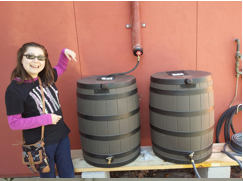
Allison Goi, like many Californians, has been concerned with the multi-year drought in this region. She wanted to focus her Caring for Our Watersheds project on water conservation and more efficient water use at her school, The MET Sacramento.
To that end, she proposed the installation of several rain barrels on campus, specifically in the garden area at school. Water collected in the barrels would be used to irrigate the various garden plantings, thus lowering the school’s city water use for this purpose.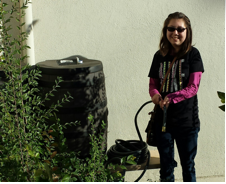
With project funds from Caring for Our Watersheds, Allison purchased (4) 50 gallon rain barrels and worked with facilities staff to install them by two downspouts in the garden area. Facilities staff modified the downspouts in order to best fill the barrels and agreed to maintain the system in the future. The barrels will collect and store a total of 200 gallons of water to be used in the garden are as needed. To make it easy to use the watering system, the barrels have been placed on shelves, 18 inches off the ground, and Allison attached 50 foot hoses to the barrels at both sites. Lastly, Allison educated the Garden Club about the project, as they will be group utilizing the system the most.
Storm “Drain Gardens”
2015 Foresthill, California, USA
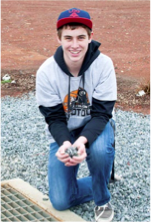
On the Foresthill High School campus, there are large areas of bare ground, especially surrounding the sports fields. As a student in teacher Katherine Cantrell’s environmental science class, Wyatt Ralston learned that when stormwater travels over bare ground, it can pick up sediment and pollutants that can negatively affect aquatic habitats. He also learned that when this storm water runoff enters storm drains, it is delivered directly back to local waterways. These two concepts led to the idea for the Storm Drain-Garden project on campus.
Ralston worked for several months to gather supplies and obtain permission to implement the project. With Caring for Our Watersheds project funding and the help of his classmates and fellow Boy Scouts, he installed gravel and native plants around four storm drains on campus to reduce erosion and to slow and filter storm water before it returns to local streams.
Ralston hopes the project will serve as a demonstration and that it will inspire home or business owners to install their own storm drain-gardens. The project will be visited and maintained by Cantrell’s future environmental science classes.
FROM GARBAGE TO GARDEN
2015, Campbellford, Ontario, Canada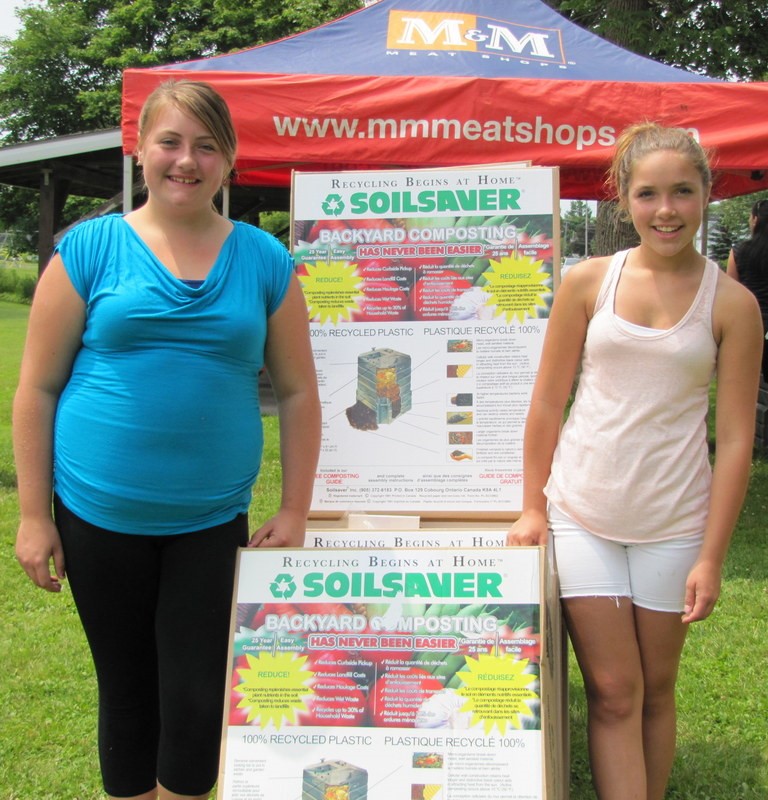
Alyssa and Josee from St. Mary’s Catholic Elementary School were appalled at how much organic household waste was going straight to the landfill. They decided to educate their community on the ease and impact of composting at home, placing 2nd overall.
The two students developed a fun and interactive way to teach people the importance of composting, and the benefits of doing so. They held the one day event at a local park, with face painting, games and a barbeque.
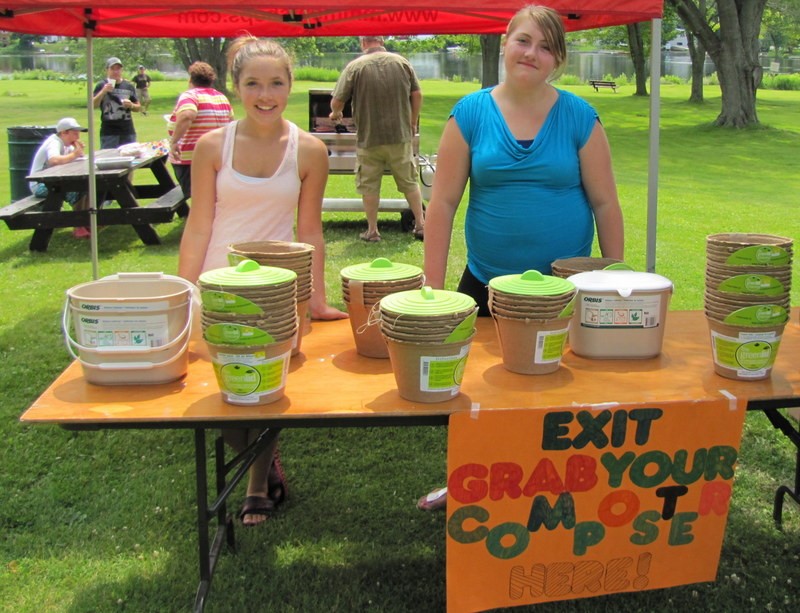 The end result of their hard work was giving away 100 composters to people in the Campbellford community. They hope that this will turn into a ripple effect and that people in their community will continue to spread the word.
The end result of their hard work was giving away 100 composters to people in the Campbellford community. They hope that this will turn into a ripple effect and that people in their community will continue to spread the word.
We NEED to recycle batteries, not throw them away
2015, Trenton, Ontario, Canada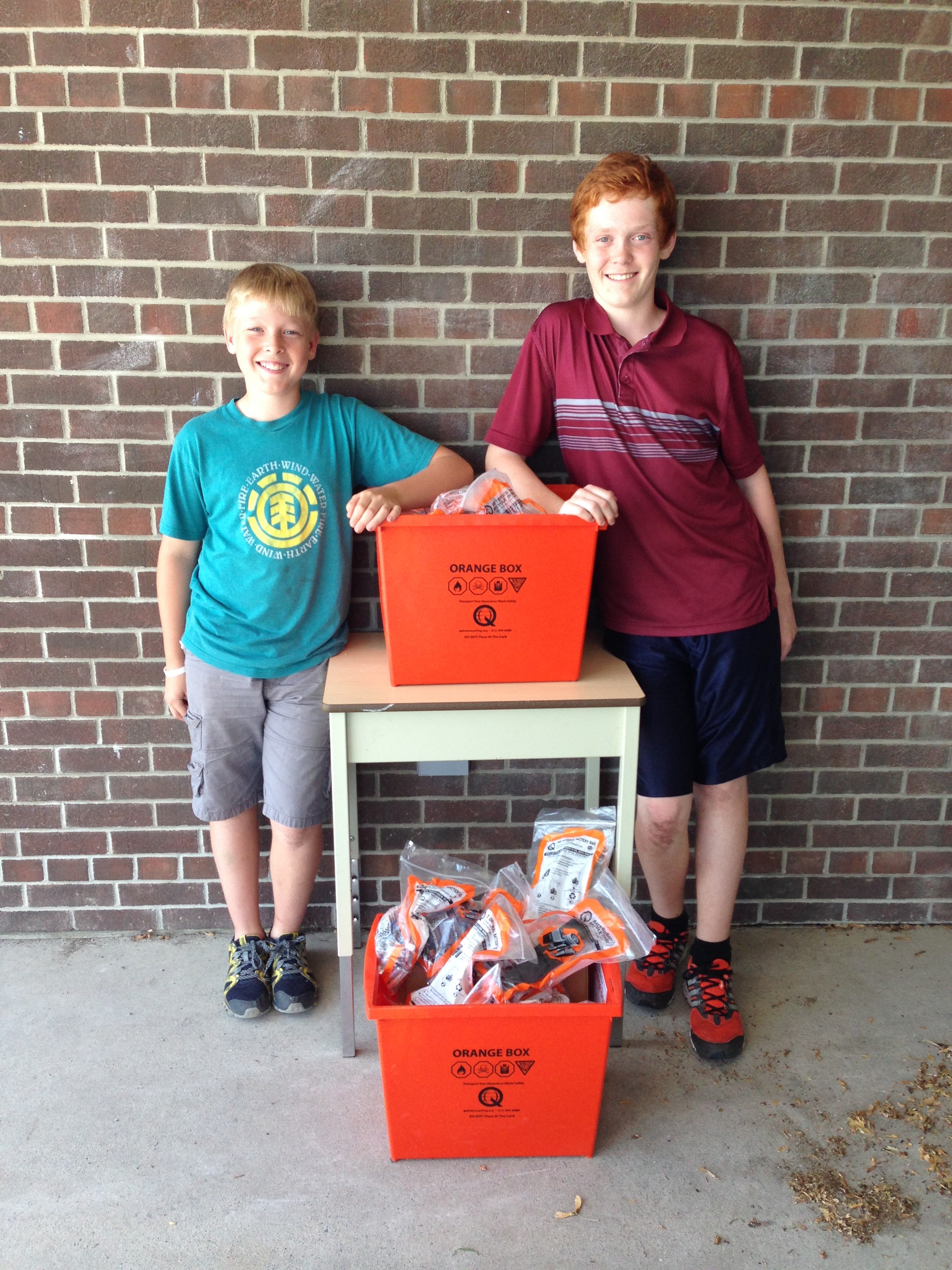
Mason and Max, grade 7 students from Murray Centennial Public School won third place for their “We need to recycle batteries not throw them away” proposal.
Mason and Max’s idea was to educate students and parents in their school community about the issue of improper disposal of batteries and organize a battery collection week at their school. The goal of their project is to reduce the number of people that don’t know what to do with their dead batteries and decrease the amount of batteries not being recycled properly.
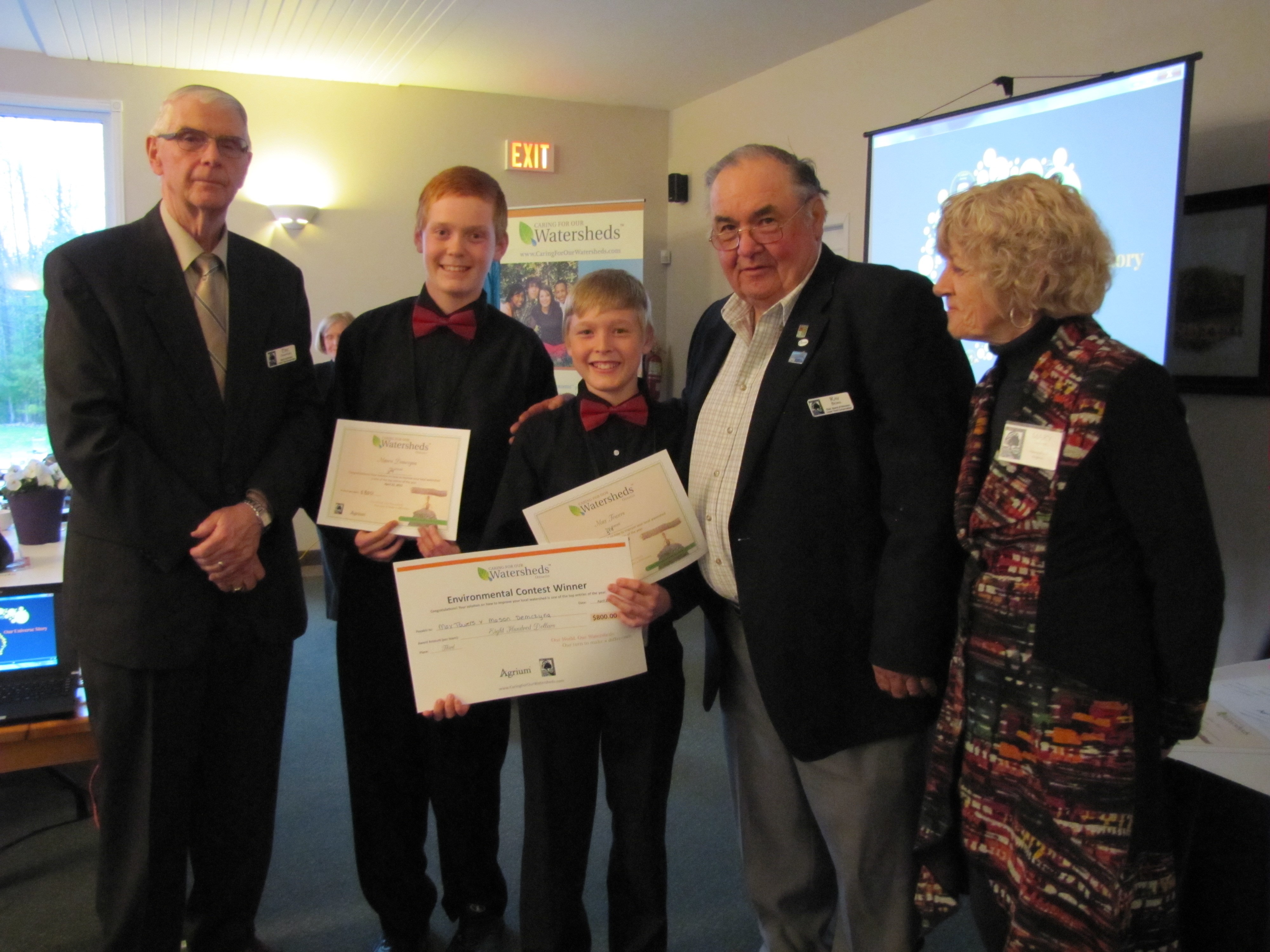 Mason and Max have already held a battery drive at their school where they collected approximately $4,000 batteries. As they are in grade 7 they will be returning to Murray Centennial in the fall of 2015 and plan to hold several battery drives in the 2015-2016 school year. Caring for our Watersheds implementation funding will be used to print educational materials promote the importance of recycling batteries and their collection program.
Mason and Max have already held a battery drive at their school where they collected approximately $4,000 batteries. As they are in grade 7 they will be returning to Murray Centennial in the fall of 2015 and plan to hold several battery drives in the 2015-2016 school year. Caring for our Watersheds implementation funding will be used to print educational materials promote the importance of recycling batteries and their collection program.
Batty for Clean Water
2015 Saskatoon, Saskatchewan, Canada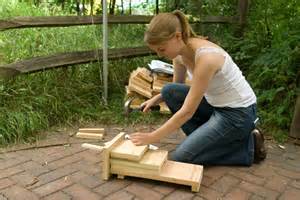
Erin and Hannah from St. Edward School came up with the idea of installing bat boxes at their school and along the Meewasin Trail to encourage the little brown bat population in the City of Saskatoon. The students felt that bats would prey upon insects, especially mosquitoes, and reduce the need for the city to spray insecticides and therefore reduce chemicals from entering our watershed.
Pesticides enter our watershed each summer. Homeowners use pesticides to kill mosquitos, ants, aphids and many other insects on their lawn and gardens. When it rains, these pesticides can be washed from lawns and gardens into storm drains and into our local river. Once pesticides get into our water it can affect the aquatic life and the 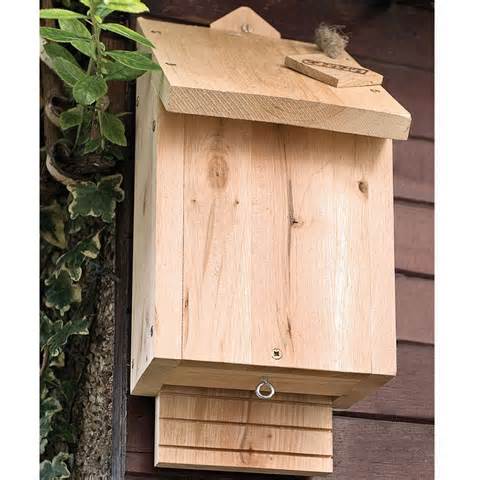 quality of our drinking water in the South Saskatchewan River Watershed.
quality of our drinking water in the South Saskatchewan River Watershed.
Bats are an important part of our watershed. They prey upon the insects that we use pesticides to control. Bats provide a natural way of controlling insect populations. Many North American bats can eat between 6000-8000 mosquito sized insects in one night!
Erin and Hannah came up with the idea of installing bat boxes at their school and donating bat boxes to Beaver Creek Conservation Area, which has many documented bat sightings. By increasing habitat for the little brown bat, a local species of bat in the Saskatoon area, it meant there would be a reduction in the insect populations in and around Saskatoon. Less insects mean less pesticides being used and a safer and healthier watershed.
The group built bat boxes with their class and developed a curriculum outcome package for teachers to do this activity with younger grades. The curriculum package was circulated around the school so more people can learn about the importance of these intrepid insect eating creatures!
Squeaky Green
2015 Saskatoon, Saskatchewan, Canada
Julia and Jasmine from 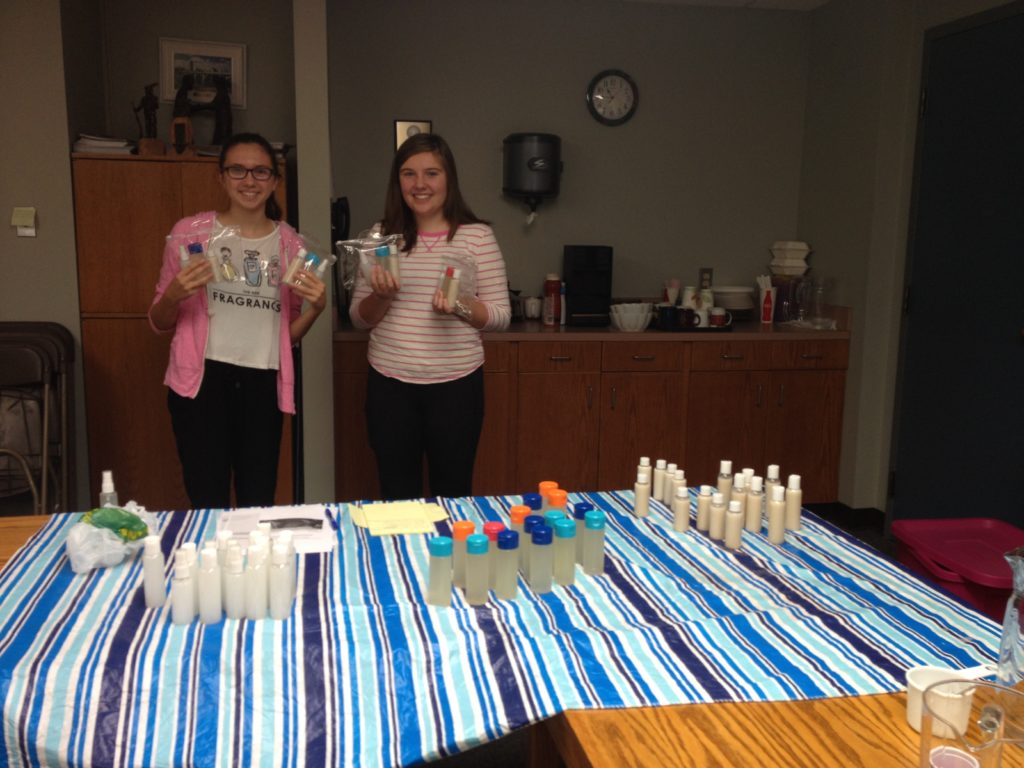 St. Edward School decided to focus their efforts on educating about the harmful effects of triclosan. Trisclosan is a preservative and anti-bacterial and anti-fungal agent found in many of the hand sanitizers, soaps, shampoos and other PCPs that we use. Studies show that triclosan can interfere with how hormones function in our bodies. It is an endocrine disrupter and can affect the reproductive systems of animals. Triclosan is also found to be very toxic to aquatic animals and can cause long term negative effects on aquatic ecosystems.
St. Edward School decided to focus their efforts on educating about the harmful effects of triclosan. Trisclosan is a preservative and anti-bacterial and anti-fungal agent found in many of the hand sanitizers, soaps, shampoos and other PCPs that we use. Studies show that triclosan can interfere with how hormones function in our bodies. It is an endocrine disrupter and can affect the reproductive systems of animals. Triclosan is also found to be very toxic to aquatic animals and can cause long term negative effects on aquatic ecosystems.
When triclosan enters our water ways it can react with other pollutants and form additional harmful compounds like dioxins which is linked to causing cancer in humans. Triclosan doesn’t easily degrade so it can build up in our rivers and lakes after washing down the drain. This means that fish can accumulate this chemical in their bodies over time, potentially becoming harmful to the other animals, including humans along the food chain.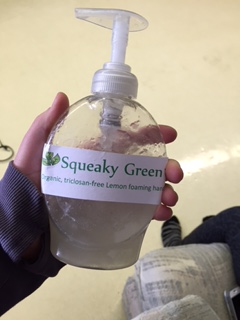
The students developed 3 triclosan-free organic consumer products: hand sanitizer, hand soap, and shampoo, and shipped out education packages and samples for teachers and students to utilize alternative products that do not include this harmful chemical. The soap contains water, castile soap, olive oil, vitamin E oil and lemon essential oil.
In order to share this information, Julia and Jasmine created a commercial that they showed to classes in their school to inform them about the problem and to share their solutions. They also developed a recipe book so that other students could create their own soaps free from chemicals.
After piloting the Squeaky Green products with their class they wanted to make a bigger impact in Saskatoon. They wanted to get more students across Saskatoon to use triclosan-free products! So, Julia and Jasmine made 40 body product sample packs. Each of these sample packs contained samples for the hand sanitizer, soap, and shampoo and a copy of the Squeaky Green recipe book that detailed how to make them. In November of 2015, these packages went to 40 schools in Saskatoon and encouraged students and teachers to become Squeaky Green and to protect our precious watershed. Students and teachers were able to see for themselves how effective Squeaky Green products are and how easy they are to make (not to mention how good they smell!).
Sammy’s Flight Over Our Watersheds
2015 Saskatoon, Saskatchewan, Canada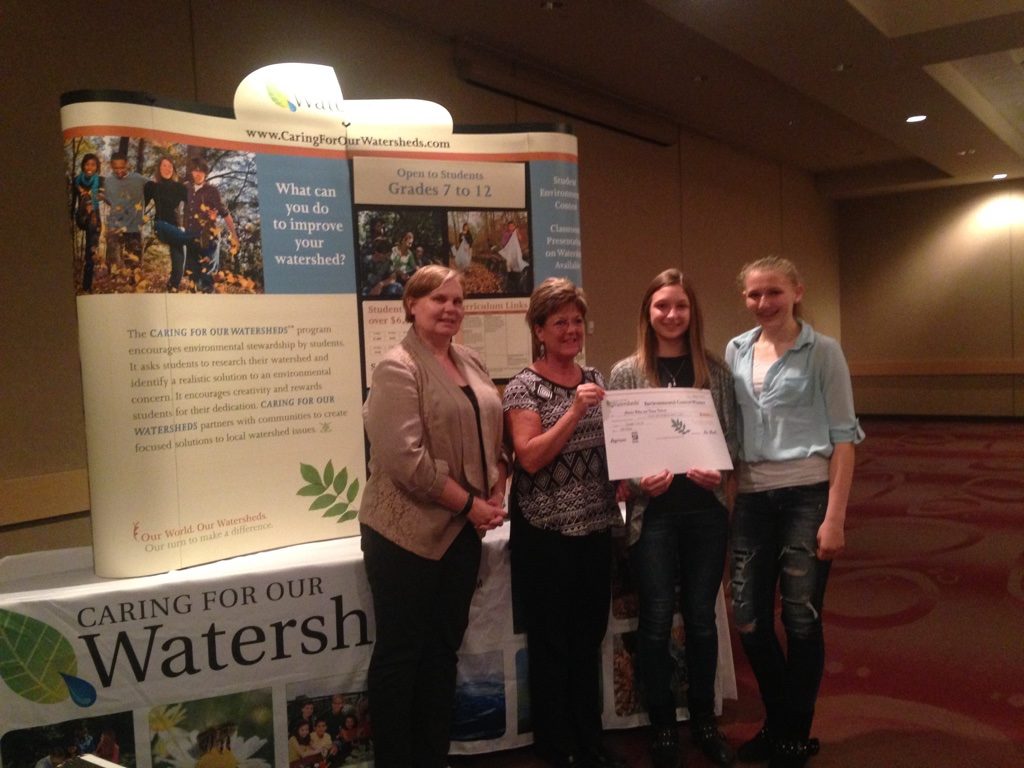
Charlee and Kelsey from St. Edward School decided that the best way to improve their watershed was by educating and instilling environmental values in the younger generation! By educating and changing the behaviours of our children and youth and developing their relationship with our environment, long term positive environmental effects are achieved. They feel more connected to their watershed and the natural world, and so they want to work towards protecting it!
The students decided the best way to do this was by developing a colourful children’s book called “Sammy’s Flight over our Watershed.” They hand drew and developed a unique storyline that follows Sammy, a young squirrel, and Callie, his bird friend who explores their watershed and discovers that it 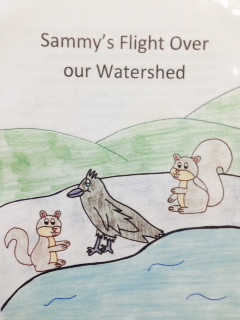 is being impacted by the careless actions of humans. The story teaches younger grades the importance of taking care of their watersheds. The book provides a number of activities the students can do to improve their watershed such as cleaning up litter, making sure their car is being washed at a car wash, responsibly using chemical fertilizers and herbicides or using alternatives, and not dumping paint or oils down the storm drain. Charlee and Kelsey read their story to a number of classes in their school and donated the book to their school library to be used as a teaching tool for school teachers in grade 1-3.
is being impacted by the careless actions of humans. The story teaches younger grades the importance of taking care of their watersheds. The book provides a number of activities the students can do to improve their watershed such as cleaning up litter, making sure their car is being washed at a car wash, responsibly using chemical fertilizers and herbicides or using alternatives, and not dumping paint or oils down the storm drain. Charlee and Kelsey read their story to a number of classes in their school and donated the book to their school library to be used as a teaching tool for school teachers in grade 1-3.
Education and awareness are the first steps to improving our local watershed. This books ensures that there are many future water protectors who have learned the importance of our watershed through Sammy’s little journey!
This book is a creative way to educate children on their watershed. It will be a great resource for teachers to use in the classroom because it covers curriculum outcomes, and parents can read it to their children at home. The children’s book was given to daycare centers and classroom teachers in their school division. The school division granted the Charlee and Kelsey permission to implement this project further if given the chance.